“Let’s get the blood pumping!”. Whether you’re doing walking before a gym session or even after a long day’s work, it’s quite evident and universal how beneficial cardiovascular exercises can be for your overall health!
While all organ systems connect the whole body together to some extent, we can argue it’s really the cardiovascular system that plays a significant role in connecting the entire body! From our head to toes, from our organs to tissues, the cardiovascular system really highlights the interconnectedness of the body!
In this chapter overview, we’ll go over some of the major points of the cardiovascular system, including function, anatomy, etc. Let’s get started!
Cardiovascular System on the MCAT: What You Need to Know
Topics on the cardiovascular system will be tested on the biology section of the MCAT and can appear both as passage based and fundamental discrete questions.
Though again hard to compute and give a certainty in terms of expected questions, try to anticipate about 3-5 questions covering the cardiovascular system.
Introductory biology account for 65% of the content covered in the Biological and Biochemical Foundations of Living Systems section (Bio/Biochem), 5% of content tested in the Chemical and Physical Foundations of Biological Systems (Chem/Phys), and 5% of material on the Psychological, Social, and Biological Foundations of Behavior (Psych/Soc).
Important Sub-Topics: Cardiovascular System
We’ll primarily divide topics covering the cardiovascular system into 2 main parts: the structure/overall function of the cardiovascular system and the composition and facets of blood.
Of course, after studying each topic individually and coming back to a whole picture, you’ll eventually see how they all come together in overall cardiovascular physiology.
1. Functions of the Cardiovascular and Lymphatic System
The primary function of the cardiovascular system centers around the whole body delivery of various molecules including nutrients, oxygen, hormones, and even cells through blood!
In addition to its function in delivery (like a postman), the cardiovascular system also functions like a trash pickup as it also transports waste products such as carbon dioxide, urea, and other toxic substances to be expelled from the body.
Given this, we can already see the vast interconnectedness that the cardiovascular system has with other organ systems! To give a few examples, its interaction with the endocrine system allows for the transport of hormones. Likewise, its interplay with the respiratory system allows for the import and expulsion of O2 and CO2, respectively.

You’ll also notice we’ve included the lymphatic system in our discussion! This is primarily because both the cardiovascular and lymphatic system are both described as being a part of the overall circulatory system which circulates fluids around the body.
While the cardiovascular system circulates blood to transport substances around the body, the lymphatic system functions to collect excess fluid that’s leaked from the blood vessels, called lymph, and return it to the bloodstream.
Additionally, the lymphatic system also has an immunological role! Scattered along the lymphatic system are lymph nodes which house our body’s lymphocytes. If the returning lymph contains any pathogens, they can be cleared at the lymph nodes while also initiating an immune response!
Full Study Notes : Primary and Secondary Functions of the Cardiovascular and Lymphatic System
For more in-depth content review on cardiovascular and lymphatic function, check out these detailed lesson notes created by top MCAT scorers.
2. Structure of the Cardiovascular and Lymphatic System
We’ll divide the structure of the cardiovascular system into 2 main parts: the heart and blood vessels. The heart is the main contractile organ which will pump blood throughout the body’s circulation. There are 4 chambers within the heart: right atrium (RA), right ventricle (RV), left atrium (LA), and left ventricle (LV).
Separating the atria and ventricles are the atrioventricular valves which have special names for each side of the heart. The tricuspid valve separates the right atrium and ventricle while the bicuspid (mitral) valve separates the left atrium and ventricle.
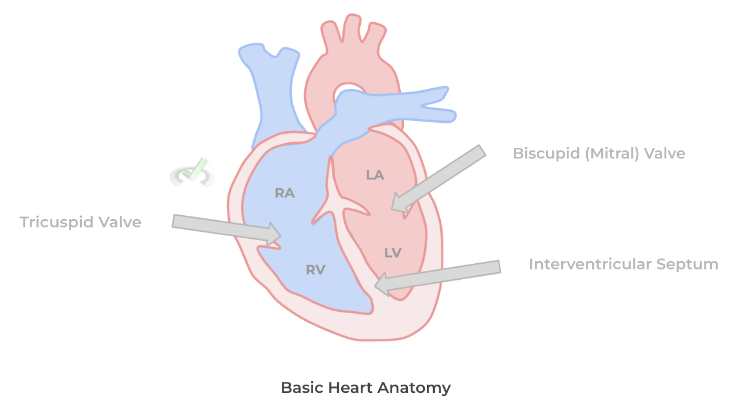
The diagram above also shows the interventricular septum, which is the cardiac tissue separating the right and left ventricles. This becomes important in order to maintain the proper directional flow of blood as we’ll see later!
The blood vessels of the cardiovascular system are arranged in a hierarchical order similar to the organization of muscle structure!
This will be better explained when talking about the flow of blood throughout the circulatory system but the basic organization of blood vessels goes as follows:
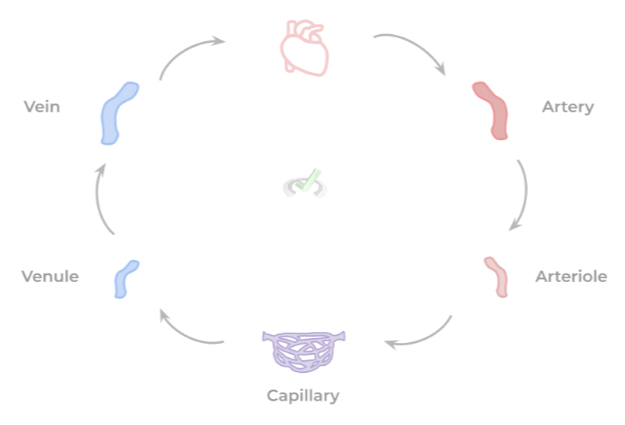
Arteries deliver oxygenated blood away from the heart and veins return deoxygenated blood back to the heart.
We say the word generally because there is an exception with pulmonary arteries and veins! In this case, the reverse occurs where the pulmonary arteries deliver deoxygenated blood away from the heart while the pulmonary veins deliver oxygenated blood back to the heart.
Similarly, the lymphatic system will transport lymph back into circulation via lymphatic vessels! However, there is a distinct difference in regards to how fluid flows between the cardiovascular and lymphatic system as mentioned in the following section.
Full Study Notes : Structure of the Cardiovascular and Lymphatic System
For more in-depth content review on cardiovascular and lymphatic system, check out these detailed lesson notes created by top MCAT scorers.
3. Flow of Blood and Lymph through Cardiovascular and Lymphatic System
In the cardiovascular system, there are 2 main circulatory circuits: the pulmonary and systemic circuit. However, both circuits are interconnected!
Blood going into the pulmonary circuit originates from deoxygenated blood in the vena cavae returning to the heart’s right side. From here, the deoxygenated blood travels to the lungs via the pulmonary arteries to be oxygenated and returns to the heart’s left side via the pulmonary veins.
Oxygenated blood entering systemic circulation will be pumped by the heart’s left side, specifically the left ventricle, and enter into the aorta which further branches out to arteries and arterioles.
The blood vessels eventually branch out to capillaries, their smallest division, and deliver oxygen and other nutrients to the tissues. From here, deoxygenated blood is collected by the venules and veins to enter the pulmonary circuit again to complete the cycle.
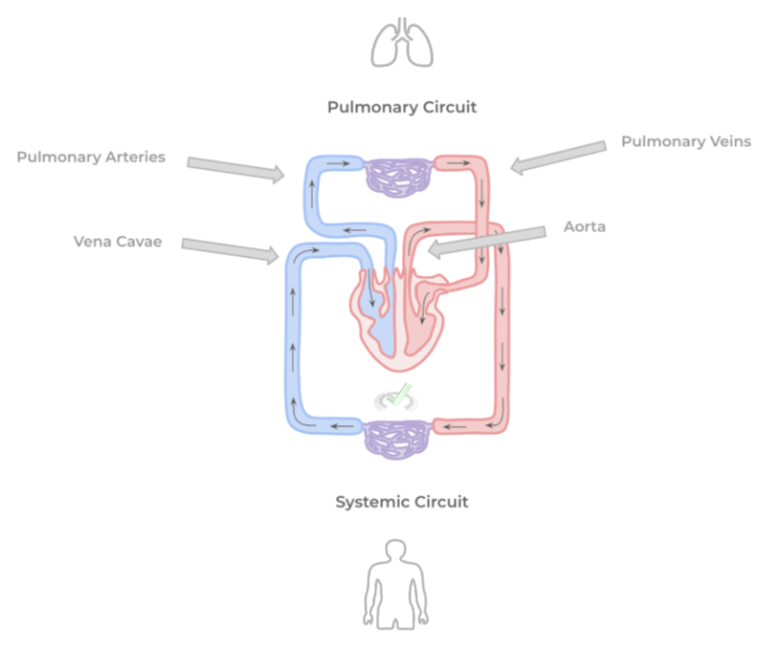
This should give a brief introduction to the flow of blood within the cardiovascular system, which we’ll cover in much more depth in our individual articles!
The flow of the lymphatic system is much simpler as lymph just returns from the tissue back into circulation. However, a key difference between fluid flow between the cardiovascular and lymphatic system is their direction.
The cardiovascular system is a 2 way, closed system while the lymphatic system is a 1 way, open system. This is because blood in the cardiovascular system flows both away and back to the heart, completing the closed circuit. However, lymph only flows one way: back towards circulation. Another way to think of it is that there are no lymphatic vessels which return lymph back to the tissue!
Full Study Notes : Flow of Blood through Cardiovascular System
For more in-depth content review on blood and lymph flow in the cardiovascular and lymphatic systems, check out these detailed lesson notes created by top MCAT scorers.
4. Blood: Composition and Function
Recall that blood is actually classified as a connective tissue as it has all the components required for connective tissue (with the exception of protein fibers) and supports the entire body!
Within blood, there are 2 main components: a cellular component and liquid component called plasma. The plasma is actually considered the ground substance for blood as a connective tissue. The 2 main cells of the cellular components are red blood cells (erythrocytes) and white blood cells (leukocytes).
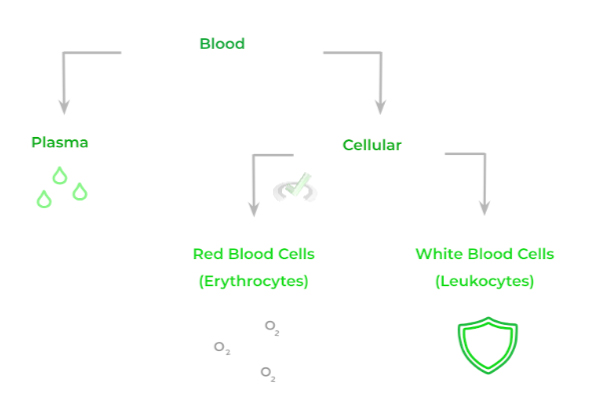
Erythrocytes function to transport and deliver oxygen throughout the body as they contain a special protein called hemoglobin which can bind O2 molecules. Leukocytes are immune cells that circulate throughout the bloodstream to respond to pathogenic infection.
In addition to being the transport medium of blood, plasma also dissolves and carries many of the necessary ions, hormones, and clotting factors throughout the body! This is due to it being composed of 90% water which allows for the dissolving of these various molecules.
An important set of molecules present within plasma is the bicarbonate buffer system where hydrogen and bicarbonate ions levels will fluctuate in order to maintain blood homeostasis.

Full Study Notes : Blood: Composition and Function
For more in-depth content review on the components of blood as well as its associated function, check out these detailed lesson notes created by top MCAT scorers.
5. Nervous and Endocrine Control of Cardiovascular System
The physiology of the cardiovascular system can also be influenced by stimuli from the nervous and endocrine system, mostly in terms of regulating blood pressure!
For example, the sympathetic and parasympathetic branches of the nervous system result in the increase and decrease of blood pressure, respectively. This occurs via the vasoconstriction and vasodilation of blood vessels via the sympathetic and parasympathetic branches.
Additionally, there are various hormones that also contribute to the regulation of blood pressure! A sure fire hormone that’ll be tested is aldosterone, which promotes sodium and water reabsorption in the kidney to increase blood volume and therefore blood pressure.
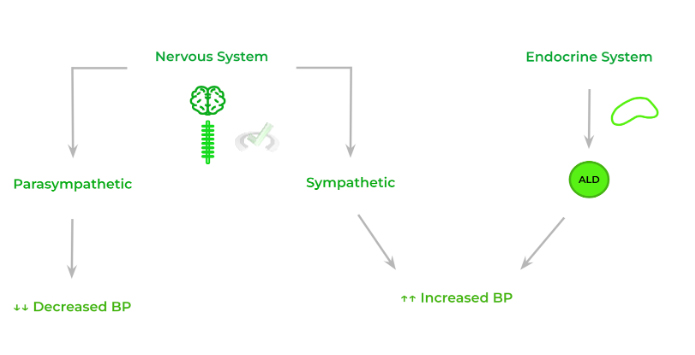
This only scratches the surface in terms of the different nervous and endocrine stimuli that can affect the cardiovascular system! Check out our detailed overview of nervous and endocrine control in the full study notes link below!
Full Study Notes : Nervous and Endocrine Control of Cardiovascular System
For more in-depth content review on the different nervous and endocrine stimuli that can affect the cardiovascular system, check out these detailed lesson notes created by top MCAT scorers.
Important Definitions and Key Terms
Below are some high yield definitions and key terms to refer to when reviewing reproduction!
Section | Number of Questions |
|---|---|
Heart | Main contractile organ of the cardiovascular system composed of 4 chambers: the right/left atrium & right/left ventricle |
Lymph | Leaked fluid within the tissue that returns back to circulation via the lymphatic system |
Tricuspid/Bicuspid (Mitral) Valve | Atrioventricular valves that separate the atria and ventricles; the tricuspid valve separates the right atrium and ventricle while the bicuspid separates the left atrium and ventricle |
Arteries | A division of blood vessels which delivers oxygenated blood away from the heart (**note: pulmonary arteries are the only exceptions!) |
Veins | A division of blood vessels which returns deoxygenated blood back to the heart (**note: pulmonary veins are the only exceptions!) |
Pulmonary Circuit | Division of cardiovascular system where deoxygenated blood is taken to the lungs to be oxygenated |
Systemic Circuit | Division of cardiovascular system where oxygenated blood is transported to all the organs and tissues in the body |
Plasma | Liquid component of blood, composed of 90% water |
Red Blood Cells (Erythrocytes) | Cells within the blood whose main function is to transport oxygen throughout the body |
White Blood Cells (Leukocytes) | Immune cells that circulate within the blood to respond to pathogenic infection |
Additional FAQs - Circulatory System on the MCAT
How Does the Heart Work – MCAT?
How Does Blood Flow Through the Heart? – MCAT?
The oxygenated blood returns back from the pulmonary circuit and travels the left atrium and into the left ventricle. Finally, the oxygenated blood enters systemic circulation to oxygenate all the body’s organs and tissues.
What are the 5 Main Parts of the Cardiovascular System – MCAT?
What Determines Blood Pressure – MCAT?
Additional Reading Links – Study Notes for Cardiovascular Systems on the MCAT
Additional Reading: MCAT Biology Topics:
- Cells on the MCAT
- Digestive Systems on the MCAT
- Embryogenesis and Development on the MCAT
- Endocrine Systems on the MCAT
- Excretory Systems on the MCAT
- Genetics and Evolutions on the MCAT
- Immune Systems on the MCAT
- Nervous Systems on the MCAT
- Musculoskeletal Systems on the MCAT
- Reproduction on the MCAT
- Respiratory Systems on the MCAT







 To help you achieve your goal MCAT score, we take turns hosting these
To help you achieve your goal MCAT score, we take turns hosting these 





















 reviews on TrustPilot
reviews on TrustPilot